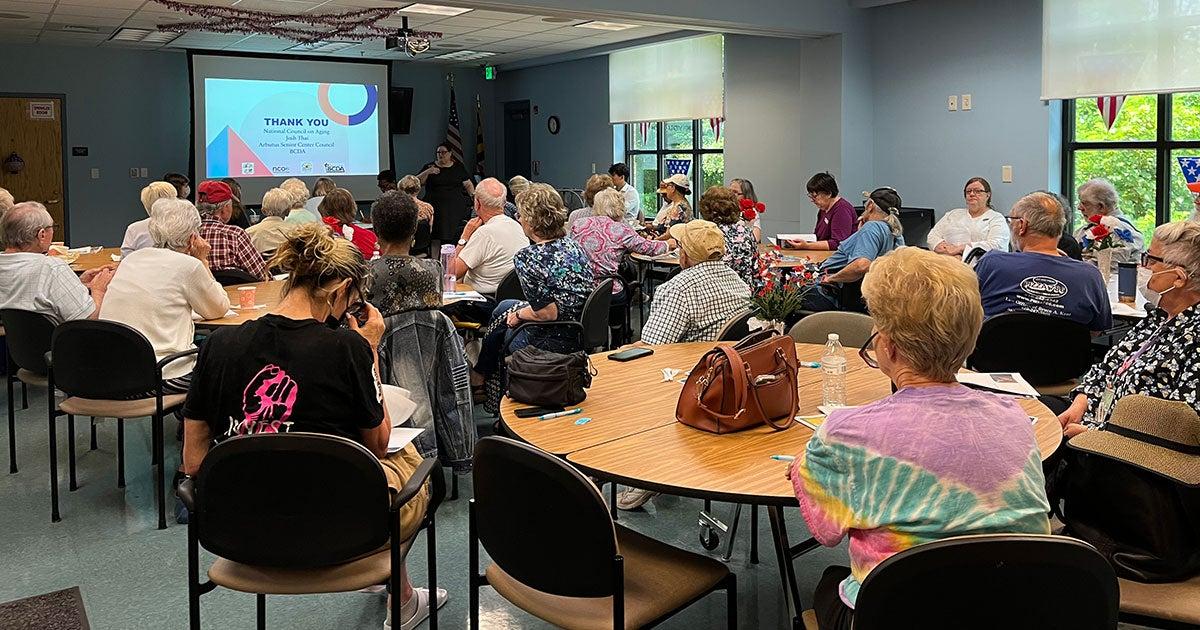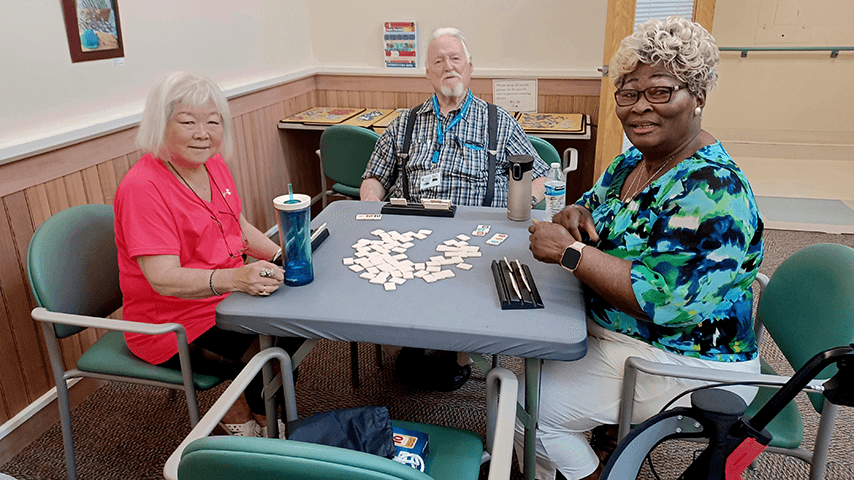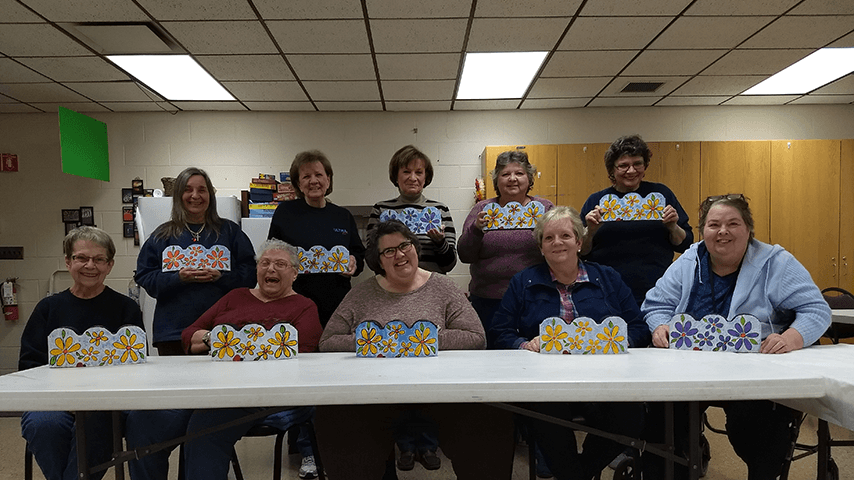Senior Center Spotlight: Stoughton Area Senior Center Stays Nimble to Feed Older Adults
5 min read

Located along the Yahara River in downtown Stoughton, Wisconsin, the Stoughton Area Senior Center provides a variety of programs, services and opportunities to serve people 55+ and their families. It is a department of the City of Stoughton, a rural community of 13,000, and the surrounding townships that boost the local population to around 30,000. The senior center is a critical community hub for older adults.
What is the history of Stoughton Area Senior Center?
The center’s current building started life as a bank. The city purchased the building in 1992, and after renovations, the center moved in in 1994. With three floors and around 15,000 square feet, the center have struggled to operate under such tight quarters. More recently, the city agreed to provide an adjacent building if the center raised the funds for the needed remodeling. Thanks to grants from two local foundations and a large gift from a participant that supplemented the center’s fundraising, the demolition is starting, and they expect to have two new and large spaces available for classes and events by the summer.
What happens at the Stoughton Area Senior Center?
The center offers a comprehensive array of programs and services. These include:
- Health and wellness programs like exercise classes
- Evidence-based programs
- Social engagement and recreation
- Volunteer opportunities
- Activities that promote creativity and learning.
As a community focal point, the center provides important information and referral services, serving as a clearinghouse of information and supportive resources for older adults, their families, the community, and agencies that serve people over the age of 55. The center plays a strong advocacy role for the community’s older adult population. They offer robust case management services, providing outreach, assessment, referrals, and assistance with issues like housing, behavioral health, substance use, economic security, and managing chronic illness. The costs of these services, including transportation, are partially funded by the Older Americans Act through the Dane County Area Agency on Aging.
According to Director Cindy McGlynn, the goal of the center is to enhance the lives of older adults, and this means something different to each person. For example, they have a wood shop that enhances the lives of participants who want to work with their hands.
The program that enhances the lives of older adults on the most basic level is the nutrition program. As a meals site of the County Senior Nutrition Program, a county contracted caterer provides meals, and the center delivers 85-90 meals a day to residents in their homes and serves an additional 20 or so in their congregate site.
These meals are incredibly important to older adults who need the balanced nutrition that these meals provide. Whether it is because they struggle to prepare a meal, to get groceries or to afford the food, these meals are lifesaving. Home-delivered meals provide an important safety net for recipients—especially those who have no family and for whom the volunteer might be the only person they see in days. For those who are able to get to the center, they benefit from the social engagement that sharing a meal brings. In addition to these Senior Nutrition Program meals, the center’s nutrition coordinator is an accomplished cook and prepares a special meal once a week in their licensed kitchen.
How has the COVID-19 pandemic impacted the senior center?
Like most senior centers, COVID-19 had tremendous impact on their operations. They shut their doors but were able to continue to provide home delivered meals. Their usual volunteers, older adults themselves, were not able to serve but the community stepped in to help. While they did outreach and transitioned programs to virtual, they witnessed the suffering that isolation brought to older adults. McGlynn reflected on how people would knock on the window asking to be allowed to come in.
After being close to in-person activity and having no in-person meals for a year, the Stoughton Area Senior Center is now almost back to their pre-pandemic attendance of 120-200 people a day coming in for activities and services that enhance their lives. There are still former participants who have not returned—the frailest among them. But there was tremendous relief in being able to return to normal operations.
How Stoughton Area Senior Center stepped up to the plate to fill sudden meals gap
That is one of the reasons why recent events have been so troubling. With no notice, the county-contracted caterer closed up shop. The 14 nutrition sites were told that they would need to come up with plans to continue operations. The county was able to provide shelf stable meals for delivery, but there was concern that these meals—intended for emergencies—were not ideal because they required the ability to open cans and microwave food. And they were told that they would need to shut their congregate meals down.
While this was a tremendously challenging situation, it was another example of how senior centers understand their participants, can innovate, can mobilize their communities, and can meet the needs of older adults. At the Stoughton Area Senior Center, the nutrition coordinator went from that one meal a week to preparing, packaging, and serving all of their home-delivered meal and congregate meal clients. They problem-solved how to covercome purchasing and storage challenges. Other centers were able to work with area restaurants to support their efforts. The county has been diligently working on the problem, and a former contractor will start to provide meals on an interim basis while a new RFP is issued.
What does modernizing mean at Stoughton Area Senior Center?
When asked what modernization meant to her center, McGlynn said that they needed to ask whether they were providing the services needed by older adults in Dane County and that they needed to ask that repeatedly as the population changes and the needs of older adults change. They are currently working on a needs assessment survey to gather that insight. An example of change was the integration of technology. While they had long thought about how to use technology to reach people who could not come to the center, COVID accelerated that need for innovation, and now they are looking at how they can use technology in their new space to offer hybrid options.
What’s Next for Stoughton Area Senior Center?
In addition to the new program space, creating sustainable funding is on McGlynn’s mind. With retirement on the (distant) horizon, she is determined to advocate for consistent and increased contributions from the townships. They are also exploring diversification of their revenue options including establishing a ‘friends’ group and an endowment fund.
One thing is clear, the Stoughton Area Senior Center will continue to be there for its community, enhancing the lives of generations of older adults.
Still not a member of the National Institute for Senior Centers? Join today, membership is free.
If your center has engaged in a recent study or assessment, we’d love to hear about it. And if you haven't already, we'd encourage you to join the National Institute of Senior Centers (NISC). Free to all senior centers (and their personnel), NISC supports senior centers with best practices and innovations in programming, as well as networking and training opportunities. Ask for help, leverage NISC resources, or share your successes like the Stoughton Area Senior Center. Find out how you can become a NISC Affiliate today.



